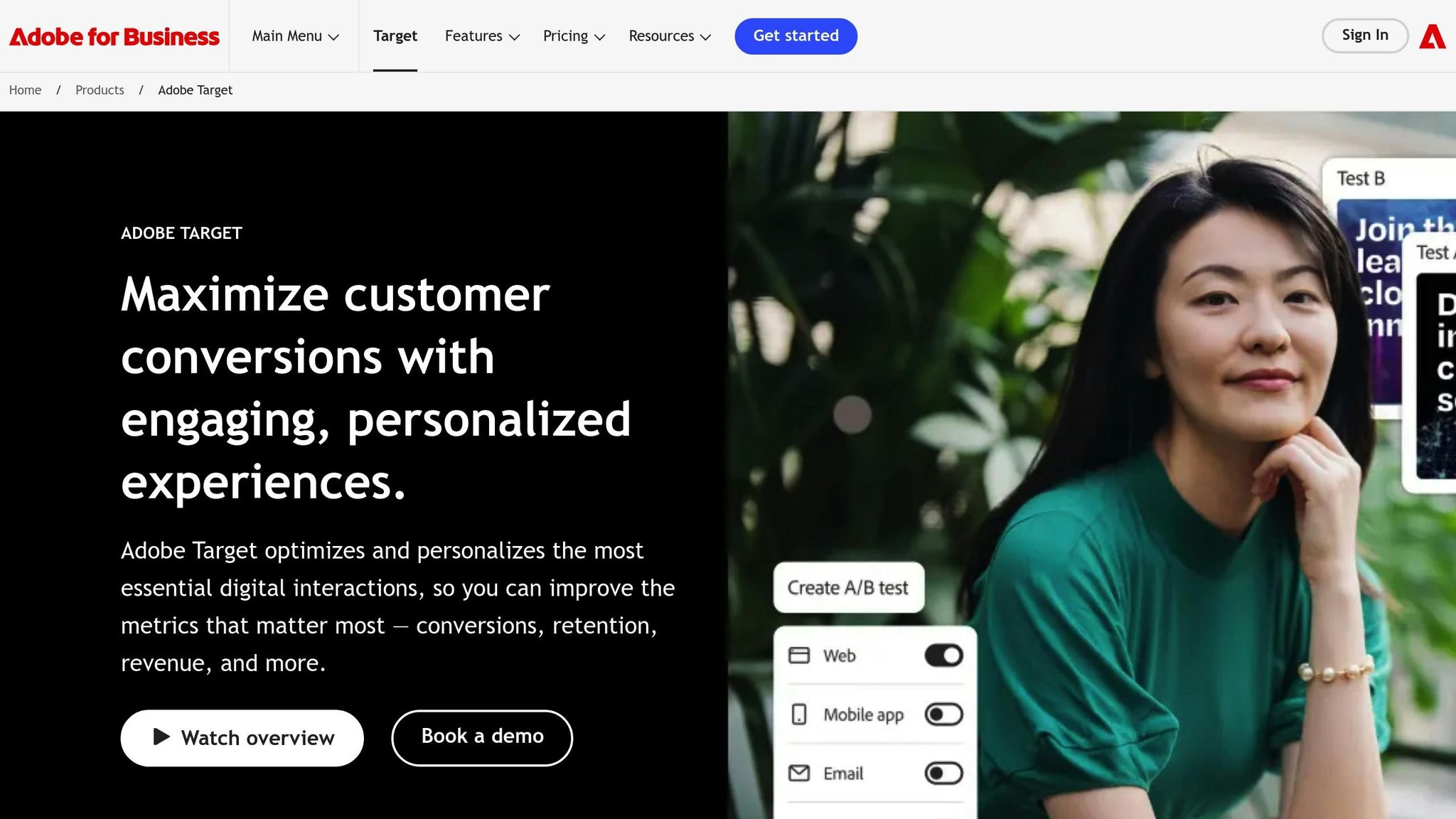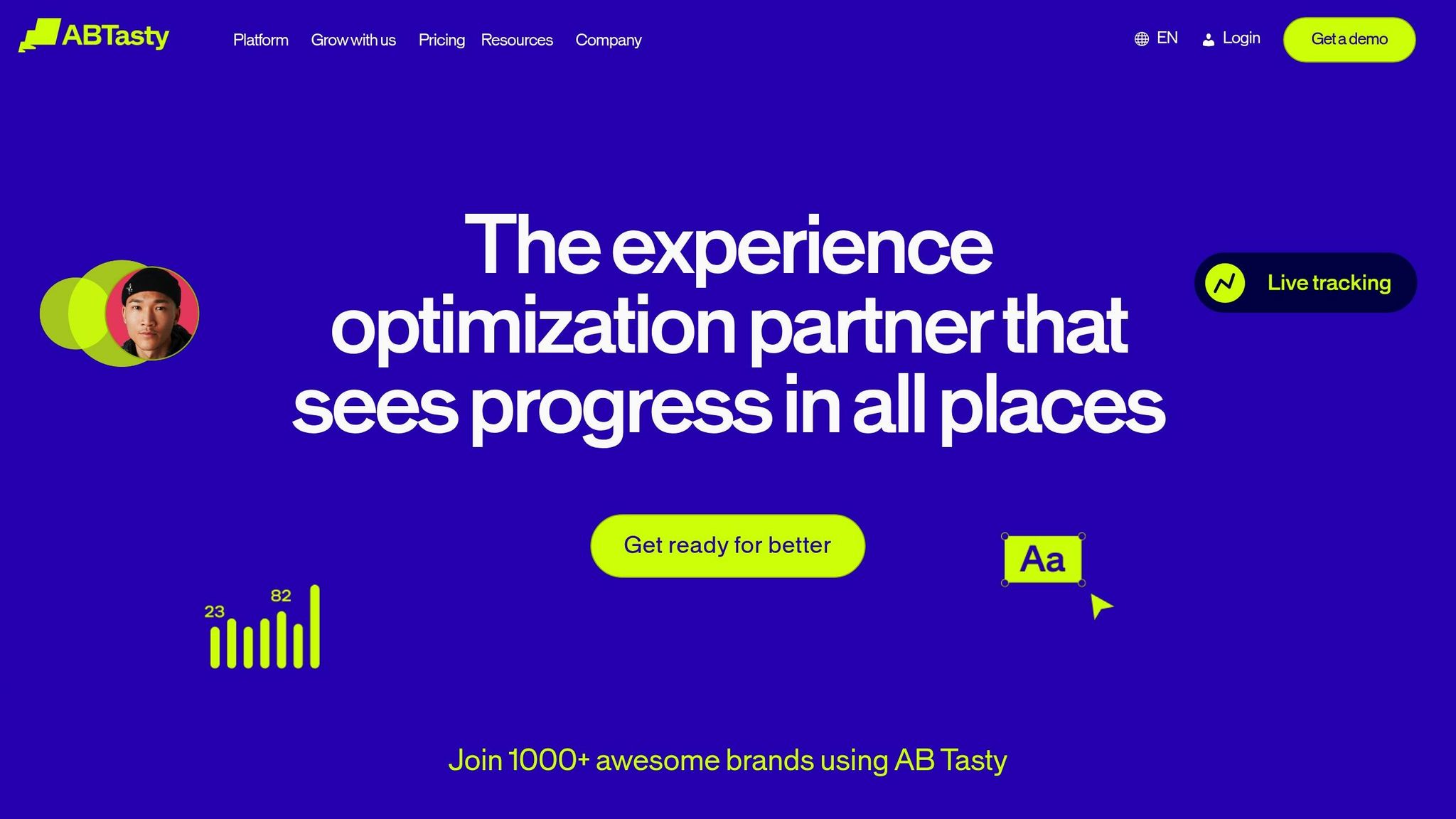A/B testing turns guesswork into data-driven strategies, helping you identify what content works best for your audience. Here’s a quick summary of the top tools for optimizing content distribution:
- VWO: Easy-to-use, AI-powered testing with integrations like Google Analytics. Starts at $154/month.
- Adobe Target: Advanced personalization and testing for enterprises. Custom pricing, integrates with Adobe tools.
- AB Tasty: Combines A/B testing and personalization, starting at $20,000/year.
- Oracle Maxymiser: Enterprise-level testing with real-time behavioral targeting. Custom pricing.
- Google Analytics 4 (GA4): Free tool for tracking and analyzing test performance.
- Marketing Funnels Directory: A resource hub for comparing tools and strategies.
A/B Testing Course 022: My favorite A/B testing tools
Quick Comparison Table
| Tool | Key Features | Integrations | Pricing | Best For |
|---|---|---|---|---|
| VWO | AI automation, heatmaps | Google Analytics, HubSpot | $154/month+ | Small-to-medium businesses |
| Adobe Target | Multi-channel personalization | Adobe Experience Cloud | Custom pricing | Enterprises with complex needs |
| AB Tasty | AI-driven audience segmentation | CRM, CMS platforms | $20,000+/year | Mid-to-large businesses |
| Oracle Maxymiser | Real-time personalization | Oracle ecosystem | Custom pricing | Large enterprises |
| Google Analytics 4 | Free event tracking, dashboards | Google ecosystem | Free | Small businesses |
| Marketing Funnels | Tool directory, resources | N/A | Directory access | Researching solutions |
These tools help you test everything from email subject lines to landing pages, ensuring your content delivers results. Start with your budget, goals, and tech stack to pick the right one.
1. VWO
VWO is a conversion rate optimization platform that simplifies A/B testing for marketing teams, regardless of their technical expertise. Its drag-and-drop interface allows users to create and launch tests quickly, without needing to write any code. The platform also offers precise targeting, enabling teams to customize tests based on location, device type, or user behavior - ensuring tests reach the right audience.
With real-time analytics, teams can instantly monitor conversion rates, engagement, and statistical significance. VWO also leverages AI to suggest testing ideas and automate variations, which is especially helpful for teams managing campaigns across multiple channels.
The platform’s impact is evident in real-world examples. In 2015, Hubstaff, a project management software company, used VWO to run homepage split tests, achieving a 49% increase in sign-ups. They averaged three tests per month, with at least five experiments running simultaneously. Similarly, the Portland Trail Blazers revamped their ticket sales funnel by redesigning their navigation menu, leading to a 62.9% increase in revenue - a statistically significant boost.
"VWO has been so helpful in our optimization efforts. Testing opportunities are endless and it has allowed us to easily identify, set up, and run multiple tests at a time."
- Elizabeth Levitan, Digital Optimization Specialist
VWO’s integration capabilities expand its utility for content distribution testing. It integrates seamlessly with tools like Google Analytics 4, HubSpot, Segment, and Demandbase. For example, its integration with HubSpot CRM enables teams to sync experimentation data directly into their CRM and import contact lists for targeted campaigns.
The platform supports various testing methods, including A/B, multivariate, and split URL tests. Using its visual editor, marketing teams can experiment with headlines, call-to-action buttons, form designs, or email campaign variations. Additionally, heatmaps and session recordings provide deeper insights into user interactions with test variations.
Pricing for VWO starts at $154 per month for up to 10,000 users, with a freemium option available. However, costs can increase significantly with additional modules, with an average annual spend of $17,543 (ranging from $7,200 to $40,548).
"The cost of VWO can get pretty steep when combining multiple modules or when implemented on higher traffic websites."
- Nicky R., UX/UI Architect
Despite the pricing, VWO remains popular among users. It holds a 4.0 out of 5 rating for value for money based on 92 reviews. Its intuitive design makes it particularly appealing for smaller teams just starting their journey into A/B testing and content distribution optimization.
2. Adobe Target

Adobe Target is a high-end A/B testing platform designed to optimize content distribution. It supports a variety of testing methods, including A/B/n, multivariate, and multi-armed bandit tests, which dynamically adjust traffic allocation to favor top-performing variations.
One of its standout features is the Visual Experience Composer (VEC), which allows marketers to set up tests without writing any code. The process is streamlined with a three-step guided workflow, making it easy to launch tests quickly. Additionally, Adobe Target supports mobile SDKs, server-side APIs, and Node.js environments, offering flexibility for different technical setups.
The platform also includes traffic estimation tools to calculate the sample size needed for statistically reliable results. This ensures that test outcomes provide actionable insights. For instance, BBVA Bank leveraged Adobe Target to run over 1,000 split tests, which led to a 20% increase in its customer base and boosted online banking adoption. Research from IDC further highlights the platform’s impact, noting a 651% ROI over three years and a 38% increase in conversion rates for users.
Adobe Target integrates seamlessly with other Adobe products, such as Adobe Analytics (A4T), Adobe Experience Manager, and Adobe Campaign. This integration allows teams to use analytics data for precise targeting and unified reporting across marketing activities. Audience segments can also be shared across platforms, enabling more in-depth performance analysis.
However, the platform’s advanced capabilities come at a cost. Pricing starts at around $40,000 per year for basic plans, with enterprise-level implementations requiring custom quotes that can go significantly higher.
While Adobe Target offers powerful features, some users report challenges, including a steep learning curve, occasional performance hiccups, and less-than-ideal customer support. Despite these drawbacks, it remains a strong choice for enterprises with complex, multi-channel strategies.
On Gartner Peer Insights, Adobe Target scores a 4.4 out of 5, with 82% of users recommending it. It performs particularly well in areas like scalability (4.5/5), integration (4.4/5), and customization (4.5/5). For businesses that prioritize advanced personalization and analytics integration, the investment in Adobe Target can pay off significantly.
3. AB Tasty

AB Tasty is an all-in-one platform for experimentation and personalization, combining A/B testing, personalization tools, and feature management into a single solution. It’s designed to enhance customer experiences across websites, mobile apps, and other digital platforms.
One standout feature is its visual, drag-and-drop editor, which allows marketers to launch tests without needing to write any code. This makes it easy for teams to quickly turn ideas into live experiments.
The platform also shines when it comes to audience segmentation and targeting. Using dataLayer variables and AI-driven segments (such as EmotionsAI), AB Tasty enables users to create highly specific audience groups. This precision ensures that content is tailored to the right users during testing, making campaigns more effective.
AB Tasty integrates seamlessly with popular tools like Google Analytics 4, Adobe Analytics, Mixpanel, and Segment. It supports both push and pull integrations - allowing users to send campaign data to external platforms or bring audience segments into AB Tasty for targeted campaigns. These integrations are easy to set up directly within the platform, requiring no coding knowledge.
The platform’s feature set includes multivariate testing, split URL testing, heatmaps, session recording, funnel analysis, and real-time reporting. To ensure optimal performance, AB Tasty incorporates tools like modular architecture, smart caching, and a dedicated Performance Center, all aimed at minimizing the impact on website load times.
Pricing starts at around $20,000 per year for basic plans, with the average contract totaling approximately $45,000 annually. While it’s positioned as an enterprise-level solution, many reviewers feel the platform offers strong value for its price.
User reviews often highlight the platform’s ease of setup, smooth integrations, and responsive customer support. However, some users note occasional drawbacks, such as limited reporting depth and minor impacts on page loading speeds due to JavaScript. Even with these considerations, AB Tasty remains a strong contender among A/B testing tools.
With its mix of user-friendly design and advanced targeting capabilities, AB Tasty is a powerful option for optimizing content distribution, complementing the other tools mentioned in this guide.
4. Oracle Maxymiser

Oracle Maxymiser is a powerful testing platform designed for enterprises. It combines A/B testing, behavioral targeting, and personalization across multiple channels, making it ideal for large organizations. The platform offers advanced split testing with real-time behavioral adjustments and automated insights, ensuring that businesses can adapt quickly to user behavior shifts.
Its visual campaign designer simplifies the process of creating and running tests with a drag-and-drop interface, suitable for both websites and mobile apps. One standout feature is its real-time behavioral targeting, which dynamically adjusts user experiences based on live data. This allows businesses to refine their content strategies instantly as user patterns evolve.
The platform excels in audience segmentation, enabling precise targeting for tests. It also provides automated performance recommendations, helping teams make data-driven decisions. These features contribute to improved user satisfaction and measurable outcomes.
On Gartner Peer Insights, Oracle Maxymiser holds a solid 4.2/5 rating from 14 reviews, with 57% of users recommending the product. Reviewers often highlight its scalability (rated 4.6/5) and integration capabilities (rated 4.3/5), though some mention a steep learning curve due to its less intuitive interface.
Integration is one of its strengths. Oracle Maxymiser connects seamlessly with Oracle's ecosystem, including RDBMS, ERP systems, Tableau, and Business Objects. It also integrates with Oracle Infinity, enabling features like heatmaps for deeper insights. This makes it an excellent choice for companies with complex, data-driven marketing strategies.
In June 2024, a reviewer from a large IT services company (with revenues between $10 billion and $30 billion) noted that Oracle Maxymiser is particularly effective for continuous and complex A/B testing. They also praised its integration with Oracle's broader suite of tools.
Pricing is provided through custom quotes, reflecting its focus on enterprise-level clients. This may make it less accessible for smaller teams or organizations.
Oracle Maxymiser is best suited for businesses looking for advanced, multi-channel testing capabilities within a sophisticated marketing environment. While it may require more effort to set up compared to simpler tools, its features are a strong asset for companies managing complex and dynamic content distribution strategies.
sbb-itb-a84ebc4
5. Google Analytics for Distribution Data
Google Analytics 4 (GA4) is a powerful and free tool that plays a key role in content distribution testing. While it doesn’t directly run A/B tests like dedicated platforms, it complements them by offering deep analytical insights that enhance testing outcomes [53, 58].
With GA4’s event tracking, you can go beyond simple page views and dive into specific user actions during A/B tests. This allows you to monitor test performance in real time and make adjustments as needed, ensuring your experiments stay on track.
One of GA4’s standout features is its flexible segmentation. You can break down data by device type, traffic source, user demographics, or behavior. For example, you might notice that a test performs differently on mobile versus desktop or that organic search users respond differently compared to those from social media.
Another major advantage is GA4’s seamless integration with tools like Google Sheets. This makes it easy to create automated dashboards for tracking test performance at a glance. Additionally, analyzing secondary dimensions - like comparing new versus returning users or different traffic sources - gives you a richer understanding of how your content variations are performing. These insights are invaluable for validating the results of tests conducted on specialized platforms, bridging the gap between experimentation and in-depth analysis.
GA4’s data framework has already proven its value in real-world scenarios. For instance, an e-learning site used GA4 to transfer audience data into VWO for an A/B test. The test split users into two groups: one saw the existing course page, while the other viewed a redesigned page featuring testimonials, detailed lesson plans, and an introductory video from the instructor. Such use cases highlight how GA4 enhances testing strategies and supports better customer solutions.
Regularly tracking content performance is crucial for marketing success, and GA4 excels at this. It allows businesses to monitor a variety of goals simultaneously, often offering more comprehensive tracking options than some dedicated A/B testing tools. Whether you’re measuring email sign-ups, event registrations, or purchase completions, GA4 provides a complete view of how your tests impact the broader marketing funnel.
To make the most of GA4, consider creating custom reports to analyze test data by device type, segmenting traffic sources, and using the Analysis section to compare results between variants [54, 55].
Best of all, GA4 is free, making it accessible for businesses of all sizes. For those looking to enhance their GA4 experience, tools like MonsterInsights (starting at $49.50 annually) can bring GA4 data directly into your WordPress dashboard with advanced tracking features. By delivering detailed, real-time insights, GA4 ensures your A/B testing efforts are grounded in solid data, helping you make smarter, more informed decisions.
6. Marketing Funnels Directory

If you're looking to strengthen your marketing strategy, the Marketing Funnels Directory is a resource worth exploring. It goes beyond just listing individual tools - it brings together a collection of software, vendor details, courses, and books designed to help you create a well-rounded content distribution strategy.
With the marketing tools market expected to skyrocket from $9.41 billion in 2025 to $34.83 billion by 2034, growing at a 15.65% CAGR, this directory can save you time by cutting through the noise. Instead of sifting through countless options, it provides a curated selection of resources tailored to fit into your marketing funnel.
The directory gives you access to detailed vendor and software information, making it easier to see how each tool aligns with your specific needs. This helps you connect the dots across multiple customer touchpoints, ensuring your strategies work seamlessly together.
It also includes courses focused on mastering sales funnels - a skill that's becoming increasingly important as the global A/B testing tools market is set to grow at an 11.5% CAGR through 2032. Whether you're dealing with the complexities of B2B marketing, like long sales cycles and multiple stakeholders, or aiming to integrate social media and advertising more effectively, this directory has resources to address those challenges.
In short, the Marketing Funnels Directory is a one-stop shop for marketers looking to streamline their efforts and stay ahead in a rapidly expanding industry.
Tool Comparison Chart
Picking the right A/B testing tool for content distribution can be a daunting task, especially with so many options out there. Recent data highlights the rapid expansion of tools designed for optimization and testing. To simplify your decision-making process, here’s a breakdown of some top solutions:
| Tool | Key Testing Features | Integration Options | Pricing | Gartner Rating | Best For |
|---|---|---|---|---|---|
| VWO | Behavior targeting, multi-armed bandit, generative AI for test automation, personalized image generation | Works with 40+ platforms, including Google Analytics, WordPress, and Shopify | Starts at $154/month, with a free plan available | 4.2/5 | Businesses needing clear pricing and broad integrations |
| Adobe Target | Multi-touch campaigns, AI-driven personalized offers, behavior targeting | Seamless integration with Adobe Experience Cloud and Adobe Analytics | Custom pricing | 4.4/5 | Enterprise teams already using Adobe tools |
| AB Tasty | Multi-armed bandit testing, audience and behavior-based targeting, AI visitor segmentation | Connects with third-party analytics, CRM, and CMS platforms | Starts around $20,000/year | 4.4/5 | Mid-to-large businesses looking for modular features |
| Oracle Maxymiser | Multivariate testing, behavioral targeting, real-time personalization | Integrates with Oracle Marketing Cloud and enterprise CRM systems | Custom pricing | 4.2/5 | Large enterprises with complex testing needs |
| Google Analytics | Basic A/B testing, audience segmentation, conversion tracking | Native integration within the Google ecosystem and select third-party platforms | Free | N/A | Small businesses just starting with testing |
| Marketing Funnels Directory | Curated tool selection, vendor comparisons, educational resources | Access to multiple testing tools and platforms through its directory | Directory access | N/A | Marketers researching and comparing solutions |
This chart captures the essentials, but each tool has unique strengths worth exploring in more depth. For example, statistical models like Bayesian or Frequentist approaches underpin the reliability of these tools' insights.
AI capabilities are becoming a game-changer in this space. VWO uses generative AI for tasks like test automation and personalized image creation. Similarly, Adobe Target employs AI to deliver personalized offers, while AB Tasty uses AI for visitor segmentation to refine targeting.
Integration and ease of use are critical factors. Adobe Target’s integration with Adobe Analytics provides robust real-time optimization, while VWO offers compatibility with over 40 platforms, ensuring flexibility. Regardless of the tool, all deliver seamless A/B testing setups, catering to businesses of various sizes.
When it comes to pricing, the options vary significantly. VWO starts at $154/month and offers a free plan, while AB Tasty’s pricing begins at approximately $20,000 per year. Tools like Adobe Target and Oracle Maxymiser follow custom pricing models, while Google Analytics stands out as a cost-effective option with its free plan.
As digital marketing budgets continue to grow, choosing the right tool is more than just a technical decision - it’s a strategic one. Consider your budget, technical needs, current tech stack, and team expertise to find the best fit for your business.
Final Thoughts
When selecting an A/B testing tool, consider factors like ease of use, statistical accuracy, integration capabilities, and your budget. Whether you're a small business exploring basic testing or a larger enterprise conducting complex multivariate experiments, there’s a tool designed to meet your specific needs. Here's a quick recap of what some of the top tools bring to the table:
- VWO: Offers flexible pricing and a wide range of integrations.
- Adobe Target: Built for enterprise-level personalization.
- AB Tasty: Provides modular features for diverse testing needs.
- Oracle Maxymiser: Excels in advanced testing for intricate requirements.
- Google Analytics: Delivers accessible insights to kickstart your testing efforts.
At the heart of successful testing lies statistical significance. Start with well-defined goals, focus on audience segmentation, and ensure your sample sizes are large enough to yield reliable results.
The potential impact of A/B testing is undeniable. For instance, personalized email subject lines have boosted open rates by 25%, content format testing has increased social media engagement by 50%, and optimized calls-to-action have driven website conversion rates up by over 30%. It’s no surprise that 51% of high-performing companies allocate significant resources to client-side testing.
If you're looking for a broader strategy or additional resources, the Marketing Funnels Directory is a great place to start. It offers curated testing tools, educational courses, and vendor comparisons, making it easier to evaluate multiple solutions. Leveraging these insights can help you refine your marketing strategy and optimize your content distribution efforts.
FAQs
What’s the best way to choose an A/B testing tool that fits my business and budget?
How to Choose the Right A/B Testing Tool
Selecting the best A/B testing tool for your business starts with understanding your specific needs and resources. Think about your team's experience with testing, the kind of experiments you want to run, and - of course - your budget. These factors will help you narrow down the options to tools that truly fit your goals.
Once you’ve outlined your needs, focus on the features that matter most. Do you need something user-friendly? Should it integrate seamlessly with your current systems? And how well can it handle your business as it grows? To make an informed decision, dive into user reviews, explore case studies, and schedule demos to see the tools in action. By taking this step-by-step approach, you'll find a solution that not only meets your requirements but also supports your content distribution strategy without breaking the bank.
What are the benefits of using A/B testing tools with analytics platforms like Google Analytics or Adobe Experience Cloud?
Integrating A/B Testing Tools with Analytics Platforms
Pairing A/B testing tools with platforms like Google Analytics or Adobe Experience Cloud offers a streamlined way to refine your content distribution strategies. By centralizing testing and analysis, marketers can eliminate the hassle of juggling multiple tools, making workflows more efficient. Plus, these integrations provide real-time insights into user behavior, enabling quicker, data-driven decisions.
On top of that, combining A/B testing with analytics tools opens the door to better personalization and smarter resource allocation. By pinpointing which content variations resonate most with users, businesses can boost conversion rates while cutting down on unnecessary spending. This not only improves the user experience but also lays a solid foundation for long-term growth and more effective strategic planning.
What steps can I take to ensure my A/B testing delivers reliable and actionable results?
To get trustworthy and useful results from your A/B testing, start by setting clear goals and forming a hypothesis. Pinpoint the metrics you’ll track - like conversion rates or click-through rates - to define success. Don’t forget to calculate the right sample size and let the test run long enough to gather substantial data. Generally, aim for a p-value under 0.05 to ensure the results are statistically significant.
When the test wraps up, take a close look at how each variant performed. Go beyond just identifying the "winner" - dig into why it outperformed the other. This deeper understanding of user behavior and preferences can shape your upcoming strategies and improve how you distribute content for even stronger outcomes.


